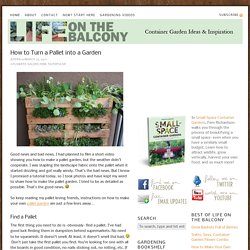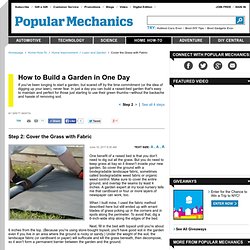

DIY Vertical Succulent Planter. SpringPlanting - Calendar. In the Garden (KCBS & KCAL 2006) Welcome to SaiFou – Inspiring images. Responses Reply Bbelaso7 Tlcnan Weezie13 They take a piece of re~bar, and put in into the ground (*a good amount so it doesn’t fall over) then they take the clay pots… put them thru the tiny hole in the bottom first (carefully/slowly as clay pots do break) and then tip or tilt each one in a different/opposite direction.. fill it with potting soil and plant your plants.. and always leave room at the top so the rebar goes over the top of the top pot, so it still has something to lean on… otherwise it tips… 99 Things You Probably Didn't Know You Can Compost. Anybody who has a composting bin or compost pile at their house knows that old apple cores, banana peels and potato skins can be composted.

The list of items that can be composted doesn’t stop there, in fact, it barely scratches the surface. Did you know that you can compost an old tea bag? Old spices? Grass clippings? How about sticky notes? There are many compostable items, and this list will get you started with the first ninety-nine. If you are composting for an organic garden use organic starting materials. The Basics Do you compost at home? - Dr. Building a Vegetable Garden - No Dig Natural Gardening - Preparing an organic Garden. Your Complete Instructions for Natural Gardening Success Behind every vegetable plant is a person with gardening desires — you!

And behind you there are bees, worms... and millions of other live inhabitants of your garden soil. To keep them happy, here's how to build your vegetable plot. There is no need to wreak havoc and madly dig. Truly, madly, digging messes up the natural layers of earth that nature has set down. Let the microbes and worms etc do what they do best in their own good way and time. Preparing a vegetable garden of this sort is extremely attractive for those sites that start off with poor soil or invasive weeds. Follow the natural gardening no dig diagram below, but first thing of course is to... Choose the site: Make sure it is roughly level and ideally most of the area gets at least 4-5 hours of sun a day. Is it level: Build any walls: If the ground is on too much of a slope, build some terraces for easy maintenance.
Soil: Plants and Flowers that will Grow Well in your Rock Garden. How to Turn a Pallet into a Garden. Good news and bad news.

I had planned to film a short video showing you how to make a pallet garden, but the weather didn’t cooperate. I was stapling the landscape fabric onto the pallet when it started drizzling and got really windy. That’s the bad news. But I know I promised a tutorial today, so I took photos and have kept my word to share how to make the pallet garden. I tried to be as detailed as possible. So keep reading my pallet loving friends, instructions on how to make your own pallet garden are just a few lines away…
Build a Garden in One Day - How to Get Started. One benefit of a raised bed is that you don't need to dig out all the grass.

But you do need to keep grass at bay so it doesn't invade your new garden. So cover the ground with a biodegradable landscape fabric, sometimes called biodegradable weed fabric or organic weed control. Make sure to cover the entire ground, and overlap the seams by least 4 inches. A garden expert at my local nursery tells me that cardboard or four or more layers of newspaper can work, too. When I built mine, I used the fabric method described here but still ended up with errant blades of grass poking up in the corners and in spots along the perimeter.
Cinderblock Succulent Planter! — J Peterson Garden Design. Last year, there was a project on Apartment Therapy’s site that made the rounds online–a super cool, industrial-looking planter made out of cinderblocks. From the moment I saw it, I knew I would do this project myself, but there were parts of the directions I didn’t like (cutting cinderblocks? No thanks!). So, I roped in my Hunky Foreman and our crew, and everybody had input into how this thing got put together. Let’s start at the end and move backwards, shall we? Here’s what we came up with: Materials: CinderblocksChicken WireWire cutters & glovesWeed block fabricSucculent soilVariety of 4″ potted succulentsVariety of topdressings: decorative rock, gravel, tumbled glass We used old and new cinderblocks, and most of them were full-sized, but we did get some that were half-sized to fill in odd spaces. Handmade Wednesday: Cinder Block Garden Planter.
July 20, 2011 23 comments Please, please, please forgive me for being late with this post! The Art of Weeding: Part 2. In Part One of this series on organic weed control we learned about how weeds affect our garden and tips to prevent them in the first place.

In this article, we'll learn how to get rid of weeds, naturally, tools for the job and how weeds can even be good for you and your garden. Real tips for getting rid of weeds As the saying goes, the bigger the elephant, the harder it is to move it. In the garden, the bigger the weeds, the harder it is to control them. The first step to controlling weedis to get into the habit of going on patrol in your garden.